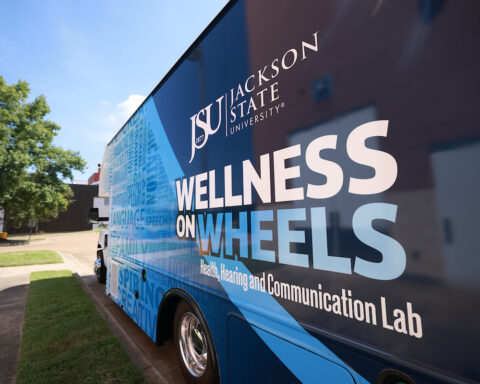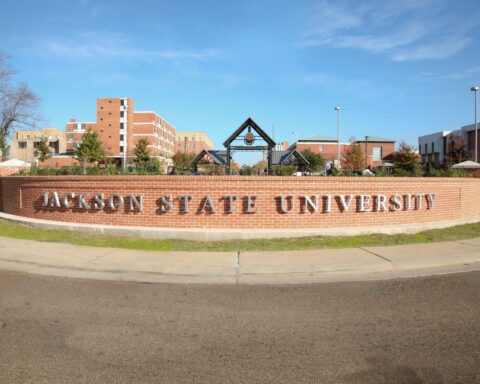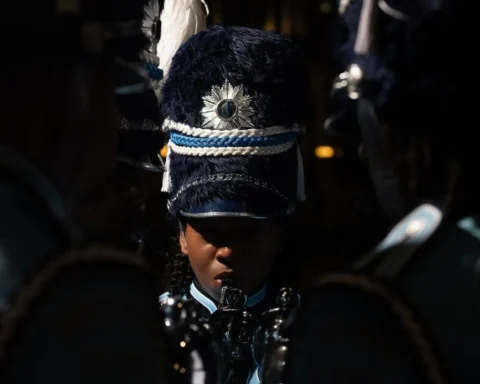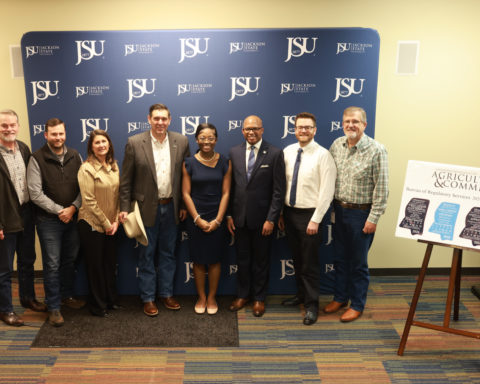By L.A. Warren
If intelligent life is discovered on another planet, JSU can boast that it played a significant role because one of its alums recently helped launch the world’s most powerful telescope that can peer back 13.5 billion years — well before humans populated the Earth.
The joy of being part of the team that developed the James Webb Space Telescope (JWST) sent Douglas J. Williams II, 26, over the moon, figuratively speaking. Now, he’s eagerly awaiting images of the universe that have never been seen before.
The College of Science, Engineering and Technology alum earned his bachelor’s degree in computer engineering in 2019. He’s a native of Kalamazoo, Michigan, although most of his family reside in the Mississippi cities of Jackson and Vicksburg.
Currently, Williams lives in Los Angeles and has worked nearly three years for Northop Grumman, an aerospace and defense technology company, which is the prime contractor that developed the telescope. Williams is an alignments engineer.
In fact, his alignments team played an integral part in supporting test and on-earth mechanical deployment procedures for the Webb telescope.
‘JWST is configured down to the thousandth of an inch’
If any part of the structural apparatus moved, “nine times out of 10 we were involved,” Williams said. “That’s not to say we single-handedly owned any one responsibility. After all, we worked in conjunction with 100-plus other incredible engineers.”
He added that “JWST is configured down to the thousandth of an inch, and my team used metrology to keep deployments within the necessary tolerances. We aided in JWST’s last opening on the ground and in simulating zero gravity with the offloading team. We monitored Webb daily in order to minimize internal stresses that tend to arise during earthquakes and deployment processes.”
Williams said his team also assisted in aligning Webb’s high-gain antenna to enable it to send and receive signals to and from Earth. “Being one of the new members on the team, I really appreciated getting to learn on such an impactful project.”
Williams said he first learned about the James Webb Space Telescope in high school.
“It was all over YouTube, and it was mentioned in a few television documentaries. From that moment, I found myself eager to learn more about the advanced capabilities and engineering going into the first space deployable telescope ever to be sent into space.”
He wants others to explore opportunities beyond Earth. “If my words reach any tech-savvy young brothers and sisters with a passion for tinkering and creating, I hope you give STEM a try. Don’t get me wrong, all the math courses can be daunting, but I think it’s worth it,” Williams said. “This journey absolutely has been incredible. JSU gave me the learning environment I needed to develop.”
More reflectively, Williams said that during his orientation at Northop Grumman, his manager casually mentioned that the company was building a telescope. She told him he could view it on the observation deck open to the public. “She didn’t mention it was Webb. Out of curiosity, I walked over and opened the door, and, to my surprise, Webb was staring right back at me. I pretty much spent most of my lunches going to the viewing room from then on.”
Eventually, his manager asked if he’d like to work alignments on Webb, and Williams said, “Absolutely!” He shared that he was beyond excited to be part of a “historic project that promises to rewrite our science textbooks.”
Webb’s infrared ability
A few months later, Williams began working on the largest, most powerful space telescope ever built. Webb is the successor to the Hubble Telescope, whose defining feature was its ability to look at the universe through ultraviolet and visible wavelengths. In contrast, Webb sees primarily in infrared, enabling it to look back billions of years to the first light after the Big Bang.
Williams said the recent launch went so well that experts now suspect that the telescope would have enough fuel to be operational well beyond its previously estimated 10-year lifespan.
“It was a very surreal experience – one that I was grateful to be able to share with my family on Christmas Day 2021,” which was the day of the launch.
Now that JWST has reached its final orbit in space after a month-long journey, Williams said, “I think that discovering potential life-bearing planets will be one of the greatest discoveries Webb makes. I’ve always thought that humanity was not alone in the universe, but I never considered that I would have anything to do with that discovery when the time came. I can’t wait to see what we find.”
Williams said that once Webb’s 18-hexagonal mirrors are fully calibrated he hopes astronomers will start implementing their Hycean planet research in pursuit of discovering alien life.
He explained that “Hycean planets are a type of exoplanet that are hotter than normal and are covered in oceans. They may have conditions to support early life, and their habitable zones are larger than those of Earth-like planets. So, there might be a better chance at locating them.”
Nevertheless, given the huge potential outcomes with the new telescope, Williams said, “It would be unfortunate for humanity to discover life on other planets without first learning how to properly treat one another on Earth.” So, Williams is challenging “earthlings” to “show respect and dignity toward others regardless of race, creed, nationality, gender, sexual orientation or disability.”





